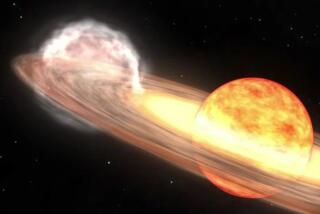Unusual Blaze of Northern Lights Awes Sky Gazers
- Share via
CHICAGO — One of the most spectacular displays of northern lights in years awed sky gazers from Ohio to Utah and as far south as Texas, where solar particles fueled curtains, ripples and clouds of night brightness.
“It was Christmas colors,” said Julia Penn of the Chicago suburb of Aurora after Friday night’s show, which lasted about 30 minutes.
“My kids were yelling: ‘Santa Claus is coming! Santa Claus is coming!’ ” she told the Aurora Beacon-News. “Oh, it was just beautiful.”
In Oklahoma City, authorities dispatched a fire truck after alarmed citizens telephoned 911 to report a red glow in the sky.
“They said they were seeing a pinkish, red haze and described it as something like nuclear lights,” an emergency services dispatcher said.
Also called aurora borealis, or “northern dawn,” the lights result when clouds of electrically charged particles from solar flares collide with the Earth’s atmosphere.
The sun is now at one of its peak periods of activity, which occur every 11 years, said David Schramm, professor of astronomy and physics at the University of Chicago.
“Now, because we’re at a sunspot maximum, the sun is having all sorts of explosions,” he said Saturday.
Each explosion has the power of at least 1,000 hydrogen bombs and throws out clouds of particles that travel to the Earth in about 24 hours, said John A. Simpson, a University of Chicago physics professor.
“The particles are very energetic,” Schramm said. “As they hit the air molecules, they cause the air molecules to glow.”
Radio stations in northern Arkansas fielded dozens of calls from listeners about the lights.
“They were fairly strong,” said Randy Davis at KHOZ, a Harrison, Ark., radio station. He said the show lasted about 45 minutes. “They moved from the east to the north, changing from orange to red.”
The lights were visible for about 20 minutes in northern Utah, said Bill Nice of Riverton. He said they looked like a “brilliant red dust cloud traveling in the wind as it went clear across the valley from the east to a northwesterly direction. It was really a brilliant red.”
Suzanne Aldrich, a lecturer at Yerkes Observatory in Williams Bay, Wis., said observers there noticed a “sheet effect, streams of light shooting up. Then it started rippling.”
More to Read
Sign up for Essential California
The most important California stories and recommendations in your inbox every morning.
You may occasionally receive promotional content from the Los Angeles Times.













